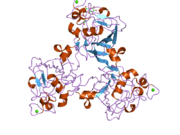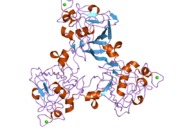Protein-coding gene in the species Homo sapiens
| FCN3 |
|---|
 |
| Available structures |
|---|
| PDB | Human UniProt search: PDBe RCSB |
|---|
| List of PDB id codes |
|---|
2J5Z, 2J60, 2J64 |
|
|
| Identifiers |
|---|
| Aliases | FCN3, FCNH, HAKA1, ficolin 3 |
|---|
| External IDs | OMIM: 604973; HomoloGene: 130523; GeneCards: FCN3; OMA:FCN3 - orthologs |
|---|
| Gene location (Human) |
|---|
 | | Chr. | Chromosome 1 (human)[1] |
|---|
| | Band | 1p36.11 | Start | 27,369,110 bp[1] |
|---|
| End | 27,374,824 bp[1] |
|---|
|
| RNA expression pattern |
|---|
| Bgee | | Human | Mouse (ortholog) |
|---|
| Top expressed in | - right lung
- upper lobe of left lung
- lower lobe of lung
- liver
- right lobe of liver
- right ventricle
- left ventricle
- metanephric glomerulus
- right adrenal cortex
- apex of heart
|
| | | More reference expression data |
|
|---|
| BioGPS |  | | More reference expression data |
|
|---|
|
| Gene ontology |
|---|
| Molecular function | - antigen binding
- protein binding
- metal ion binding
- carbohydrate binding
- serine-type endopeptidase activity
| | Cellular component | - extracellular region
- collagen
- blood microparticle
| | Biological process | - complement activation, lectin pathway
- complement activation
- recognition of apoptotic cell
- negative regulation of RNA biosynthetic process
- immune system process
- innate immune response
- proteolysis
| | Sources:Amigo / QuickGO |
|
| Orthologs |
|---|
| Species | Human | Mouse |
|---|
| Entrez | | |
|---|
| Ensembl | | |
|---|
| UniProt | | |
|---|
| RefSeq (mRNA) | | |
|---|
| RefSeq (protein) | | |
|---|
| Location (UCSC) | Chr 1: 27.37 – 27.37 Mb | n/a |
|---|
| PubMed search | [2] | n/a |
|---|
|
| Wikidata |
|
Ficolin-3 is a protein that in humans is encoded by the FCN3 gene. Ficolin-3 was initially identified as H-ficolin, in which H is after the Hakata antigen that was previously found as an autoantigen in patients who lived in the city of Hakata.[3][4][5]
Ficolins are a group of proteins which consist of a collagen-like domain and a fibrinogen-like domain. In human serum, there are two types of ficolins, both of which have lectin activity. The protein encoded by this gene is a thermolabile beta-2-macroglycoprotein found in all human serum and is a member of the ficolin/opsonin p35 lectin family. The protein, which was initially identified based on its reactivity with sera from patients with systemic lupus erythematosus, has been shown to have a calcium-independent lectin activity. The protein can activate the complement pathway in association with MASPs and sMAP, thereby aiding in host defense through the activation of the lectin pathway. Alternative splicing occurs at this locus and two variants, each encoding a distinct isoform, have been identified.[5]
References
- ^ a b c GRCh38: Ensembl release 89: ENSG00000142748 – Ensembl, May 2017
- ^ "Human PubMed Reference:". National Center for Biotechnology Information, U.S. National Library of Medicine.
- ^ Sugimoto R, Yae Y, Akaiwa M, Kitajima S, Shibata Y, Sato H, Hirata J, Okochi K, Izuhara K, Hamasaki N (Sep 1998). "Cloning and characterization of the Hakata antigen, a member of the ficolin/opsonin p35 lectin family". J Biol Chem. 273 (33): 20721–7. doi:10.1074/jbc.273.33.20721. PMID 9694814.
- ^ Akaiwa M, Yae Y, Sugimoto R, Suzuki SO, Iwaki T, Izuhara K, Hamasaki N (Jun 1999). "Hakata antigen, a new member of the ficolin/opsonin p35 family, is a novel human lectin secreted into bronchus/alveolus and bile". J Histochem Cytochem. 47 (6): 777–86. doi:10.1177/002215549904700607. PMID 10330454. S2CID 40514218.
- ^ a b "Entrez Gene: FCN3 ficolin (collagen/fibrinogen domain containing) 3 (Hakata antigen)".
Further reading
- Yae Y, Inaba S, Sato H (1991). "Isolation and characterization of a thermolabile beta-2 macroglycoprotein ('thermolabile substance' or 'Hakata antigen') detected by precipitating (auto) antibody in sera of patients with systemic lupus erythematosus". Biochim. Biophys. Acta. 1078 (3): 369–76. doi:10.1016/0167-4838(91)90158-v. PMID 1859827.
- Inaba S, Okochi K, Yae Y (1991). "Serological studies of an SLE-associated antigen-antibody system discovered as a precipitation reaction in agarose gel: the HAKATA antigen-antibody system". Fukuoka Igaku Zasshi. 81 (9): 284–91. PMID 2276712.
- Matsushita M, Kuraya M, Hamasaki N (2002). "Activation of the lectin complement pathway by H-ficolin (Hakata antigen)". J. Immunol. 168 (7): 3502–6. doi:10.4049/jimmunol.168.7.3502. PMID 11907111.
- Tsujimura M, Miyazaki T, Kojima E (2003). "Serum concentration of Hakata antigen, a member of the ficolins, is linked with inhibition of Aerococcus viridans growth". Clin. Chim. Acta. 325 (1–2): 139–46. doi:10.1016/S0009-8981(02)00274-7. PMID 12367778.
- Strausberg RL, Feingold EA, Grouse LH (2003). "Generation and initial analysis of more than 15,000 full-length human and mouse cDNA sequences". Proc. Natl. Acad. Sci. U.S.A. 99 (26): 16899–903. Bibcode:2002PNAS...9916899M. doi:10.1073/pnas.242603899. PMC 139241. PMID 12477932.
- Zeng L, Dai J, Ying K (2003). "Identification of a novel human angiopoietin-like gene expressed mainly in heart". J. Hum. Genet. 48 (3): 159–62. doi:10.1007/s100380300025. PMID 12624729.
- Clark HF, Gurney AL, Abaya E (2003). "The secreted protein discovery initiative (SPDI), a large-scale effort to identify novel human secreted and transmembrane proteins: a bioinformatics assessment". Genome Res. 13 (10): 2265–70. doi:10.1101/gr.1293003. PMC 403697. PMID 12975309.
- Ota T, Suzuki Y, Nishikawa T (2004). "Complete sequencing and characterization of 21,243 full-length human cDNAs". Nat. Genet. 36 (1): 40–5. doi:10.1038/ng1285. PMID 14702039.
- Anderson NL, Polanski M, Pieper R (2004). "The human plasma proteome: a nonredundant list developed by combination of four separate sources". Mol. Cell. Proteomics. 3 (4): 311–26. doi:10.1074/mcp.M300127-MCP200. PMID 14718574.
- Zhang Z, Henzel WJ (2005). "Signal peptide prediction based on analysis of experimentally verified cleavage sites". Protein Sci. 13 (10): 2819–24. doi:10.1110/ps.04682504. PMC 2286551. PMID 15340161.
- Gerhard DS, Wagner L, Feingold EA (2004). "The status, quality, and expansion of the NIH full-length cDNA project: the Mammalian Gene Collection (MGC)". Genome Res. 14 (10B): 2121–7. doi:10.1101/gr.2596504. PMC 528928. PMID 15489334.
- Otsuki T, Ota T, Nishikawa T (2007). "Signal sequence and keyword trap in silico for selection of full-length human cDNAs encoding secretion or membrane proteins from oligo-capped cDNA libraries". DNA Res. 12 (2): 117–26. doi:10.1093/dnares/12.2.117. PMID 16303743.
- Liu T, Qian WJ, Gritsenko MA (2006). "Human plasma N-glycoproteome analysis by immunoaffinity subtraction, hydrazide chemistry, and mass spectrometry". J. Proteome Res. 4 (6): 2070–80. doi:10.1021/pr0502065. PMC 1850943. PMID 16335952.
- Muzny DM, Scherer SE, Kaul R (2006). "The DNA sequence, annotation and analysis of human chromosome 3". Nature. 440 (7088): 1194–8. Bibcode:2006Natur.440.1194M. doi:10.1038/nature04728. PMID 16641997.
- Garlatti V, Belloy N, Martin L (2007). "Structural insights into the innate immune recognition specificities of L- and H-ficolins". EMBO J. 26 (2): 623–33. doi:10.1038/sj.emboj.7601500. PMC 1783469. PMID 17215869.
- Honoré C, Hummelshoj T, Hansen BE (2007). "The innate immune component ficolin 3 (Hakata antigen) mediates the clearance of late apoptotic cells". Arthritis Rheum. 56 (5): 1598–607. doi:10.1002/art.22564. PMID 17469142.

 2j5z: H-FICOLIN COMPLEXED TO GALACTOSE
2j5z: H-FICOLIN COMPLEXED TO GALACTOSE 2j60: H-FICOLIN COMPLEXED TO D-FUCOSE
2j60: H-FICOLIN COMPLEXED TO D-FUCOSE 2j64: H-FICOLIN
2j64: H-FICOLIN

















